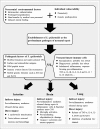Beyond sepsis: Staphylococcus epidermidis is an underestimated but significant contributor to neonatal morbidity
- PMID: 29405832
- PMCID: PMC5955464
- DOI: 10.1080/21505594.2017.1419117
Beyond sepsis: Staphylococcus epidermidis is an underestimated but significant contributor to neonatal morbidity
Abstract
Staphylococcus epidermidis accounts for the majority of cases of neonatal sepsis. Moreover, it has been demonstrated to be associated with neonatal morbidities, such as bronchopulmonary dysplasia (BPD), white matter injury (WMI), necrotizing enterocolitis (NEC) and retinopathy of prematurity (ROP), which affect short-term and long-term neonatal outcome. Imbalanced inflammation has been considered to be a major underlying mechanism of each entity. Conventionally regarded as a harmless commensal on human skin, S. epidermidis has received less attention than its more virulent relative Staphylococcus aureus. Particularities of neonatal innate immunity and nosocomial environmental factors, however, may contribute to the emergence of S. epidermidis as a significant nosocomial pathogen. Neonatal host response to S. epidermidis sepsis has not been fully elucidated. Evidence is emerging regarding the implication of S. epidermidis sepsis in the pathogenesis of neonatal inflammatory diseases. This review focuses on the interplay among S. epidermidis, neonatal innate immunity and inflammation-driven organ injury.
Keywords: Staphylococcus epidermidis; bronchopulmonary dysplasia; inflammatory disorders; innate immunity; necrotizing enterocolitis; neonatal sepsis; preterm infants; white matter injury.
Figures

Similar articles
-
Look Who's Talking: Host and Pathogen Drivers of Staphylococcus epidermidis Virulence in Neonatal Sepsis.Int J Mol Sci. 2022 Jan 13;23(2):860. doi: 10.3390/ijms23020860. Int J Mol Sci. 2022. PMID: 35055041 Free PMC article. Review.
-
The role of Staphylococcus epidermidis in neonatal sepsis: guarding angel or pathogenic devil?Int J Med Microbiol. 2014 Jul;304(5-6):513-20. doi: 10.1016/j.ijmm.2014.04.013. Epub 2014 May 6. Int J Med Microbiol. 2014. PMID: 24881963 Review.
-
Staphylococcus epidermidis and Staphylococcus aureus trigger different interleukin-8 and intercellular adhesion molecule-1 in lung cells: implications for inflammatory complications following neonatal sepsis.Acta Paediatr. 2013 Oct;102(10):1010-6. doi: 10.1111/apa.12350. Epub 2013 Aug 5. Acta Paediatr. 2013. PMID: 23845107
-
An underestimated pathogen: Staphylococcus epidermidis induces pro-inflammatory responses in human alveolar epithelial cells.Cytokine. 2019 Nov;123:154761. doi: 10.1016/j.cyto.2019.154761. Epub 2019 Jun 18. Cytokine. 2019. PMID: 31226437
-
Staphylococcus epidermidis in feedings and feces of preterm neonates.PLoS One. 2020 Feb 3;15(2):e0227823. doi: 10.1371/journal.pone.0227823. eCollection 2020. PLoS One. 2020. PMID: 32012172 Free PMC article.
Cited by
-
Antimicrobial resistance and virulence determinants in coagulase-negative staphylococci isolated mainly from preterm neonates.PLoS One. 2020 Aug 4;15(8):e0236713. doi: 10.1371/journal.pone.0236713. eCollection 2020. PLoS One. 2020. PMID: 32750089 Free PMC article.
-
Molecular Methodologies for Improved Polymicrobial Sepsis Diagnosis.Int J Mol Sci. 2022 Apr 19;23(9):4484. doi: 10.3390/ijms23094484. Int J Mol Sci. 2022. PMID: 35562877 Free PMC article. Review.
-
Altered hepatic metabolism mediates sepsis preventive effects of reduced glucose supply in infected preterm newborns.Elife. 2025 Feb 24;13:RP97830. doi: 10.7554/eLife.97830. Elife. 2025. PMID: 39992703 Free PMC article.
-
Single-cell Sequencing of Circulating Human Plasmablasts during Staphylococcus aureus Bacteremia.J Immunol. 2024 Dec 1;213(11):1644-1655. doi: 10.4049/jimmunol.2300858. J Immunol. 2024. PMID: 39451041 Free PMC article.
-
New Threats from an Old Foe: Methicillin-Resistant Staphylococcus aureus Infections in Neonates.Neonatology. 2018;114(2):127-134. doi: 10.1159/000488582. Epub 2018 May 25. Neonatology. 2018. PMID: 29804104 Free PMC article. Review.
References
Publication types
MeSH terms
LinkOut - more resources
Full Text Sources
Other Literature Sources
Medical
